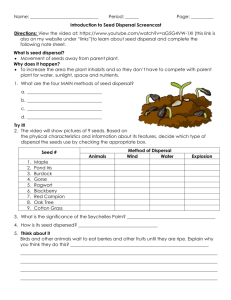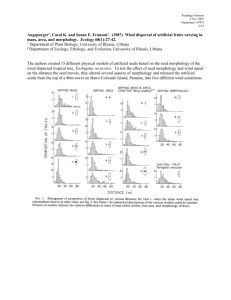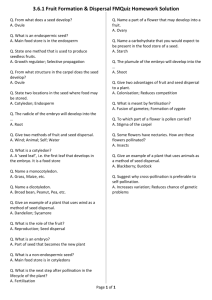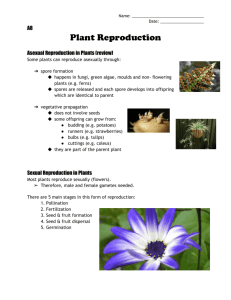8. Spores, seed and fruit - New Zealand Plant Conservation Network
advertisement
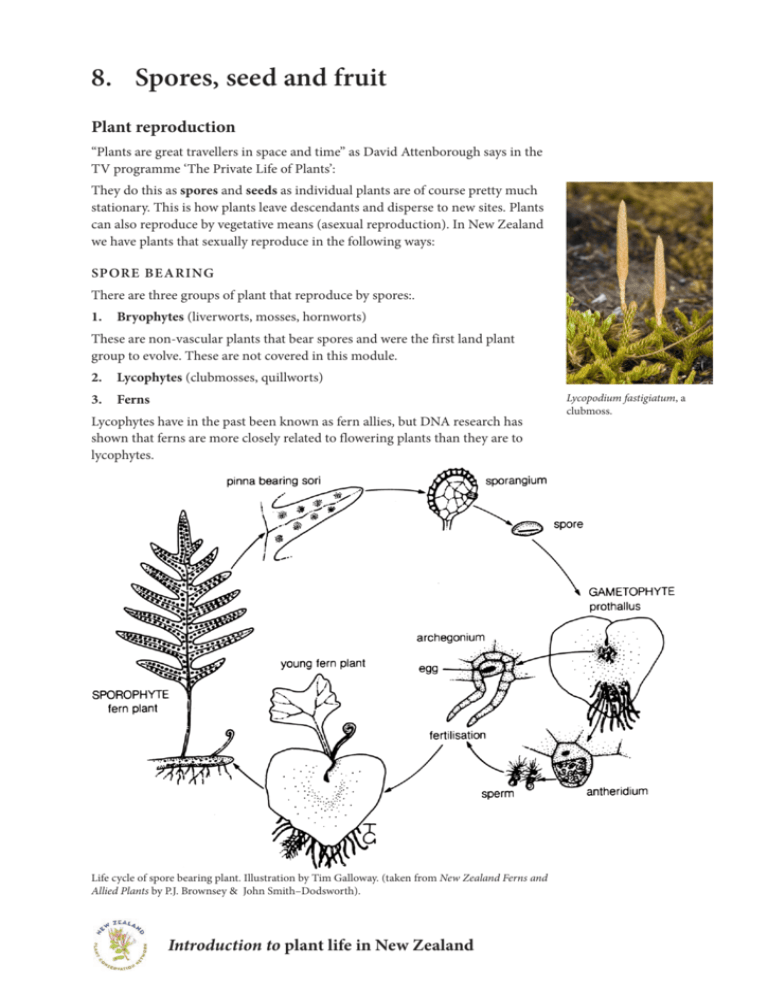
8. Spores, seed and fruit Plant reproduction “Plants are great travellers in space and time” as David Attenborough says in the TV programme ‘The Private Life of Plants’: They do this as spores and seeds as individual plants are of course pretty much stationary. This is how plants leave descendants and disperse to new sites. Plants can also reproduce by vegetative means (asexual reproduction). In New Zealand we have plants that sexually reproduce in the following ways: SPORE BEARING There are three groups of plant that reproduce by spores:. 1.Bryophytes (liverworts, mosses, hornworts) These are non-vascular plants that bear spores and were the first land plant group to evolve. These are not covered in this module. 2.Lycophytes (clubmosses, quillworts) 3.Ferns Lycophytes have in the past been known as fern allies, but DNA research has shown that ferns are more closely related to flowering plants than they are to lycophytes. Lycopodium fastigiatum, a clubmoss. Life cycle of spore bearing plant. Illustration by Tim Galloway. (taken from New Zealand Ferns and Allied Plants by P.J. Brownsey & John Smith–Dodsworth). Introduction to plant life in New Zealand 29 SEED BEARING (SPERMATOPHYTES) Two groups of plants reproduce with seeds: gymnosperms (conifers) and angiosperms (flowering plants). 1. Conifers “cone bearers” (gymnosperm) kauri, kaiwaka, podocarps, celery pines Kauri. Photo: John Smith-Dodsworth podocarp = “foot seed” The cone is obvious in kauri and kaiwaka although small in the latter. It is reduced to a single scale in podocarps though surrounded by, or borne on, a fleshy stalk—the seed (fruit) is at foot of fruit hence the name podocarp = foot seed. The life cycle is shown below: Life cycle of a cone bearing plants. Note the two dispersal units—pollen and seed. 2. Flowering Plants (angiosperms) This is the largest group of plants in New Zealand. See the following life cycle: 30 Introduction to plant life in New Zealand Gymnosperms produce cones instead of flowers. There are usually separate male and female cones. Flowering Stage Flowers are the sex organs of the plant and produce sperm (pollen) and ova. Fertilisation Stage Pollen comes in contact with the ova by various agents (wind, insects, birds, etc.) Growth Stage The plant grows into an adult capable of flowering. Fruiting/Seeding Stage The fertilised flower or cone produces fertile seed, usually encased in or attached to a fruit of some sort or on the original cone. Germination Stage If the new location is favourable, the seed germinates into a seedling. Dispersal Stage The seed is dispersed by various agents (wind, water, animal, etc.) and lodges in a different place. Life cycle of a flowering plant Life stage for seed bearing plants Life stages are the different forms the plant takes during its life span. This can be important for identification and for such things as cultivation and translocation. There are six common life stages for canopy trees from seed to adult plant: Seed The matured ovule without accessory parts, contained in a fruit or cone. Common to all flowering and cone bearing plants. Juvenile A plant of non-reproducing size. May be heteroblastic (having different leaf shapes from the adult). Seedling A newly germinated plant. Pole A subcanopy size individual, with long thin trunk and foliage tuft, of a potential canopy tree. Sapling A juvenile tree which has reached the stage of 1 or 2 main stems. Still in the shrub layer. Adult A mature plant of maximum stature and form, capable of reproducing. Life stages of kahikatea, Dacrycarpus dacrydioides. Introduction to plant life in New Zealand 31 Types of fruit Fruits are another useful identification clue. Fruit are matured ovaries and are often attractive to birds and mammals to aid seed dispersal, but essentially they form a case to transport or protect the seed. Fruits are either succulent/ fleshy (i.e., juicy or watery) or dry (no flesh or juice). Seed ID is a more specialised field and is not covered in this module. Refer to Seeds of New Zealand gymnosperms & dicotyledons by Colin J. Webb & Margaret J.A. Simpson. Below are some different types of fleshy and dry fruit. Berry: simple, fleshy, multi- Drupe: simple, fleshy, oneseeded Dehiscent/pod: bursts spontaneously when opening. e.g., Alseuosmia pusilla. e.g., karaka (Corynocarpus laevigatus). e.g., willowherb (Epilobium nummulariifolium). Nut: hard, one-seeded. Achene: small, dry, oneseeded, thin pericarp. Capsule: dry, dehiscent, formed from two or more carpels. seeded. e.g., Gahnia setifolia. e.g., Brachyglottis compacta. e.g., mänuka (Leptospermum scoparium). 32 Introduction to plant life in New Zealand Dispersal mechanisms for plants Dispersal is crucial to plants to ensure they spread out and form expanded or new populations. To achieve this, plants use five basic methods of dispersal: Animal: edible, catching. Wind: lightness, parachutes, wings. e.g., bidibidi (Acaena anserinifolia). e.g., fireweed (Senecio diaschides). Water: flotation. Ballistic dehiscent: capsule splits open explosively to expel seeds. e.g., mangrove (Avicennia marina subsp. australasica). e.g., broom (Carmichaelia australis). Gravity: seed fall. e.g., rengarenga (Arthropodium cirratum). Introduction to plant life in New Zealand 33




